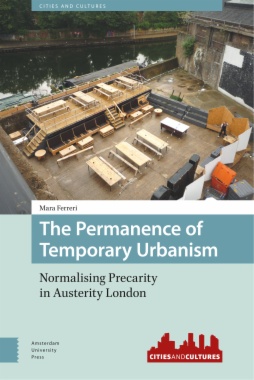Temporary urbanism has become a distinctive feature of urban life after the 2008 global financial crisis. This book offers a critical exploration of its emergence and establishment as a seductive discourse and as an entangled field of practice encompassing architecture, visual and performative arts, urban regeneration policies and planning. Drawing on seven years of semi-ethnographic research, it explores the politics of temporariness from a situated analysis of neighbourhood transformation, media representations and wider political and cultural shifts in austerity London. Through a longitudinal engagement with projects and practitioners, the book tests the power of aesthetic and cultural interventions and highlights tensions between the promise of vacant space re-appropriation and its commodification. Against the normalisation of ephemerality, it presents a critique of the permanence of temporary urbanism as a glamorisation of the anticipatory politics of precarity which are transforming cities, subjectivities and imaginaries of urban action.
- Cover
- Table of Contents
- Acknowledgements
- 1. Temporary urbanism: a situated approach
- Reclaiming spaces and the role of temporariness
- The trope of temporariness as alterity
- For a situated approach to temporary urbanism
- ‘Post-crisis’ London
- The book’s questions
- Bibliography
- 2. The entangled field of temporary urbanism
- The emergence of a discourse
- Countering recessional perceptions
- ‘Creative’ fillers
- Art showcasing to the world: pop-ups in the shadow of the 2012 Games
- The rise of the pop-up intermediary
- Meanwhilers: a clever rebranding
- The Meanwhile London Competition
- Enrolling urban professionals in the shift to austerity
- The unresolved question of unlawful occupations
- Conclusions: the primacy of property
- Bibliography
- 3. ‘Not a pop-up!’
- The experience of performers and visual artists
- A well-established history
- ‘Provided you can beg, steal or borrow a space’
- Group+Work and 1990s myths in public commissioning
- Pop-ups in Westminster
- ArtEvict in ‘forgotten spaces’
- Settling down in Hackney Wick Fish Island?
- Pop-up spaces as festivals and digital arts incubators
- Conclusions: in the cracks of the creative city promise
- Bibliography
- 4. Staging temporary spaces
- Experiential economies and the performativity of urban activation
- Staging ‘pop-up shops’ in the Elephant & Castle Shopping Centre
- The Elephant as a site for community engagement
- Studio at the Elephant
- A strategy of open programming
- Visibility for recognition
- Mediating face-to-face interactions
- Empowerment for surrender?
- Conclusions: the openness of agonistic encounters
- Bibliography
- 5. Planning a temporary city of on-demand communities
- Temporariness in planning at times of austerity
- ‘Stitching the fringes’ before and after the Olympics
- Learning from Others: interim uses as urban ‘testing sites’
- Vacant land and setting up a temporary community hub
- Young people and the two communities
- Risky grassroot
- Temporary urban vitality in the LLDC Local Plan (2015-2031)
- ‘Seeding’ long-term uses
- Learning to become ‘on-demand communities’
- Conclusions: the risk of planned precarisation
- Bibliography
- 6. The normalisation of temporariness
- Underused spaces as a ‘problem’
- The projective logic
- Ephemeral architectures
- Urban festivalisation and labour precarity
- Permanent times of uncertainty
- Tactical or precarious acting?
- Precarity as temporal foreclosure
- Reclaiming urban space-time after the pop-up
- Bibliography
- Bibliography
- Index

